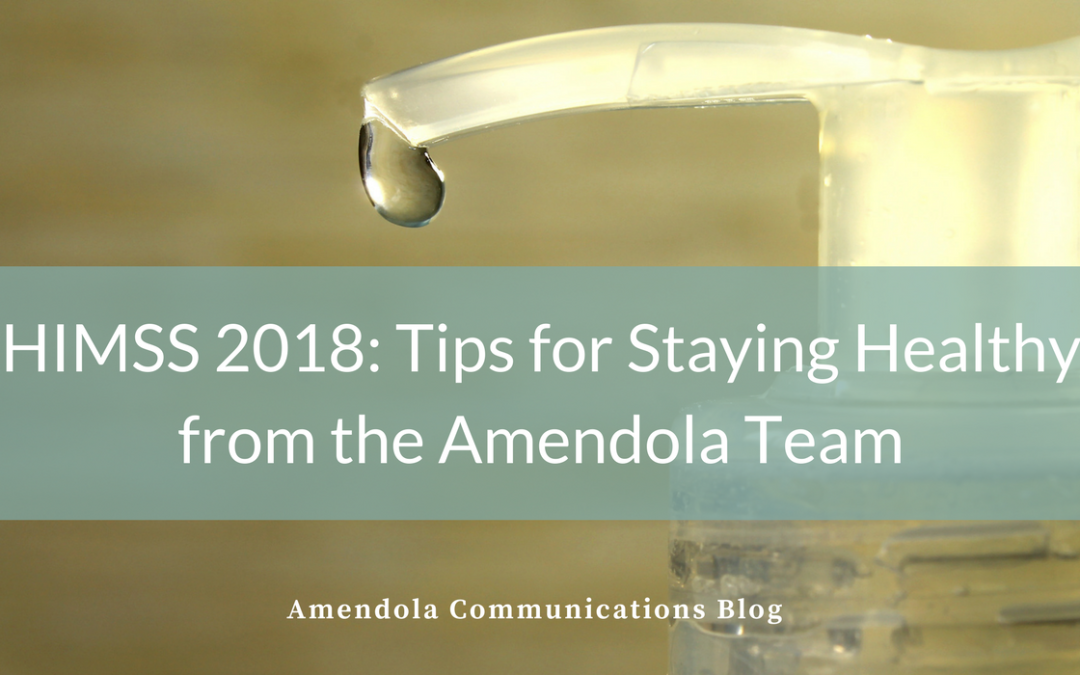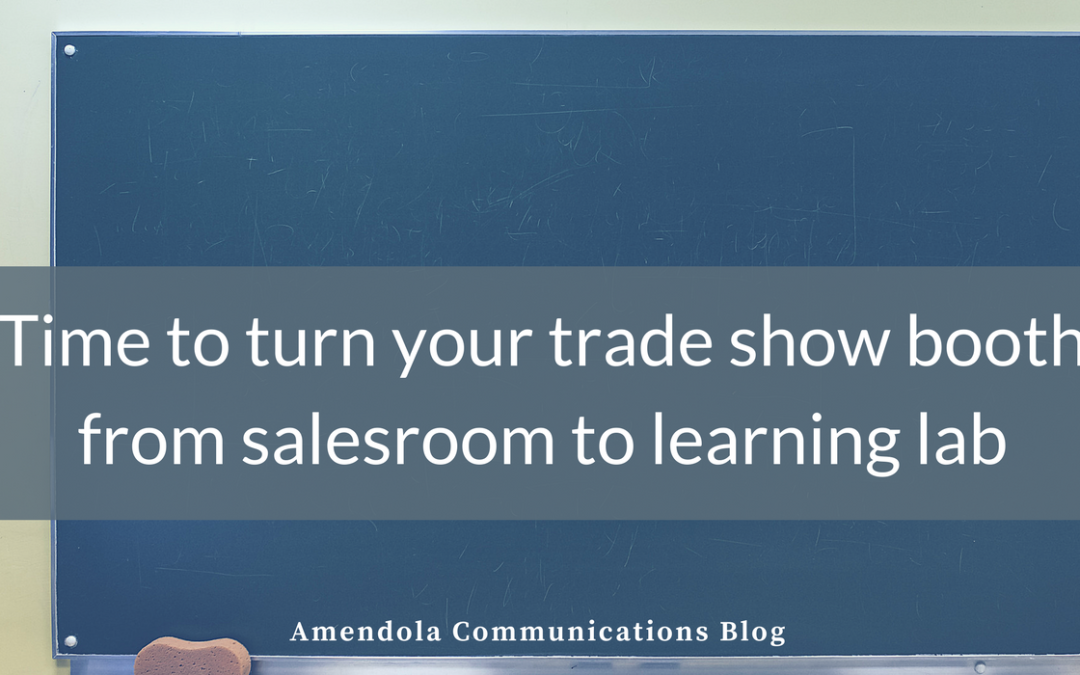
by admin | Feb 21, 2018 | Blog
Back in 2016, the Amendola Communications team collaborated on a blog post offering tips on how to stay healthy at HIMSS. With HIMSS 2018 coming up right as the U.S. in the midst of a flu epidemic, that sage advice is even more apropos.
You’re about to find yourself in a largely environmentally closed room with 42,000 of your industry compatriots. Many of those folks first walked through an airport and shared the same recirculated air in a jam-packed jet. It’s like a scenario from a disaster movie.
Even without all of that, it’s still a physical and mental marathon. It’s five straight days of being on point, on message, and on your feet. It’s HIMSS! To help you survive it, and perhaps avoid becoming one more tick in the flu statistics this year, here are some tips from the team at Amendola, who have years of HIMSS conferences under our belt.
Michelle Noteboom, Senior Account and Content Director: Assume you won’t get eight hours of sleep a night but find a way to get at least six. Make sure to drink a ton of water, which helps to hydrate you from all those late night adult beverages, and, seems to help a bit with swollen feet. Assume your feet will be swollen and your shoulders aching from lugging all the trinkets you collect from exhibitors. To that end, don’t forget Advil and Band-Aids for your feet. Bring healthy snacks for your hotel room, and finally, don’t skimp on coffee. That weak hotel room stuff doesn’t cut it when you have to be “on” for 18 hours straight. HIMSS requires a Venti Starbucks!
Margaret Kelly, Research Coordinator: Bring an emergency kit. For women, pack a clear-plastic and easy-to-get-to bag full of small amounts of Tylenol (or pain reliever of choice), Tums, “handitizor” (as my granddaughter calls it), bandages for the shoe blisters, safety pins, Chapstick, protein bar, and breath mints. The men’s version just substitute the safety pins with duct tape, and a fanny pack for the plastic bag!
Todd Stein, Vice President: Be sure to schedule time for lunch. Many people fill up their schedules without remembering to leave time for eating. Me, for instance. Every darn year.
Amy Koehlmoos, Senior Account Director and Resident Germaphobe suggests bringing the following:
- Raw almonds (they’re small, portable, healthy and provide good energy)
- Anti-bacterial wipes (for the trays, arm/head rests in the plane; and the faucets, door handles, light switches in the hotel room)
- Small Ziploc baggies (I put remote controls in these as those suckers are the #1 place for nasty germs in hotel rooms!)
- Hand sanitizer (you shake lots of hands at these events!)
- Earplugs (help you get a good night’s sleep in a hotel, where there are often weird sounds and loud neighbors)
- Shoes with arch support (my philosophy is you look better wearing an orthopedic pair of shoes with confidence than you do limping around with a pained expression on your face and a pair of sassy heels on your feet)
- Phone/connections to loved ones (mental health is important and having easy access to pictures of family and the ability to Facetime them at night makes it a bit easier to be away from home).
Ken Krause, Senior Account and Content Director and our other Resident Germaphobe:
- Drive instead of fly. Planes are breeding grounds for germs, and they keep recirculating.
- Assume everything you’re about to touch has been previously touched by a small child with a runny nose. Proceed accordingly. That goes double for your hotel room.
- Eat like your significant other is there watching you. Nothing good comes from visiting the snack machine.
- Try not to touch your eyes or nose after touching a common surface such as a doorknob until you can either wash your hands or use a cleanser such as Purell.
- Get to sleep as soon as you can rather than staying up watching TV or reading. Sometimes business travel calls for working on minimal sleep, but don’t go out of your way to get into that state.

by Stephanie Janard | Feb 14, 2018 | Blog
“Be sure to bring back lots of product literature from the trade show,” said no one ever.
As my colleague Lisa Chernikoff pointed out in a recent blog, people simply don’t go to trade shows to buy your product. They go to learn. But when they approach your booth, what do they see to compel them to stay and learn something new? If you’re drawing a blank, it’s okay. That’s what this blog post is for: to show you some new ways to draw traffic in your booth and impart meaningful information that will “stick” with attendees well after they leave.
Strategy #1: Instead of a banner announcing your product or company, announce that “class is in”
Does your company address patient engagement, value-based care or some other hot concept in healthcare? Consider making your entire booth a class in this concept, with the appropriate banner, such as “Value-Based Care 101” or “Patient Engagement Pop-Up University.” And sure, by all means include “presented by (your company)” or your company logo. But make sure this is the secondary, less prominent message.
Strategy #2: Instead of a demo, offer a class or game
Once you’ve attracted the attendee’s interest with your signage, be sure to make good on its promise. Offer attendees an experience that imparts valuable knowledge to them. Here a customer champion can be recruited to give short 20-minute presentations about their success in addressing the theme of your booth, such as value-based care or patient engagement. To capture leads, have attendees register for the session. Make sure this isn’t a product pitch, though. While some mention of your product can be given, attendees want to hear a real world story from their peer not an infomercial.
A quiz that asks provocative questions paired with equally provocative answers is another effective way to make knowledge (and by extension, your company) “stick” with an attendee.
Even a standard product demo can be upgraded to a more experiential event. In one example, Medicomp, an Amendola client, takes attendees through a virtual experience in the form of a game, which is essentially a 3-minute product preview. It highlights the key capabilities and product features, as well as the streamlined user experience, in the context of winning a prize rather than buying a product. The experience gets attendees interested in learning more and helps to weed out the wrong people so the Medicomp team knows when it’s appropriate to invest time in a full demo.
Strategy #3: Instead of brochures, put out case studies, guides and other learning material
It’s not that product literature doesn’t have its place, but on its own, a brochure is most valuable to pack rats who can’t stand to throw anything away. But as Chernikoff bluntly notes in her blog, even that fate is unlikely.
“Nobody wants your marketing brochure! It will end up in the next trash can even if they take it, and if it makes it back to their room, it will end up in the hotel trash can. They also really don’t want a folder with multiple product one-pagers and a recent press release about your new product,” she writes.
A better idea, Chernikoff continues, is to give attendees material such as case studies that illustrate real-world scenarios while highlighting your unique value proposition. I would add to that guides, how-to’s, checklists and other learning material that, collectively, will make the reader far more knowledgeable on a topic than he or she was before.
Of course, the material should be compellingly written so that it will actually be read and if you are going to invest in producing this material, it’s wise to also invest in a professional writer to write it.
We’ve created a number of such pieces for various clients to use at their trade shows, including a compilation of “user tips and strategies” for Bayer to hand out at RSNA; a brief on new technology services and trends for the lab for 4medica to distribute at the Lab Confab; and case studies for our client HealthBI to pass out to attendees at a regional conference.
Strategy #4: Instead of cheap tchotchkes, raffle off a quality and related prize
In keeping with the educational theme of your booth, how about raffling off a mini-library of interesting books on the topic your booth addresses? (All the better if your company authored one of the books!) You could open up the raffle to anyone, or narrow it down to attendees of your various learning sessions. Be sure to offer to ship some or all of the books for free, as traveling with more than a few will be difficult for most attendees.
Another idea: give attendees a thumb drive titled “Teach Your Own Patient Engagement Class” or “Value-Based Care 102” or something similar that is stocked with educational content.
In conclusion, keep in mind that an educational trade show booth also aligns well with today’s information-hungry buyers. You’ve likely heard that when it comes to big ticket items, most people have made up their mind what they’re going to buy and from whom–before they actually reach out to a vendor. This is why so many companies have an educational, content marketing strategy in place today, and why it makes sense to take a similar approach with your tradeshow booth. Make it a place of learning and watch the traffic and good leads follow.

